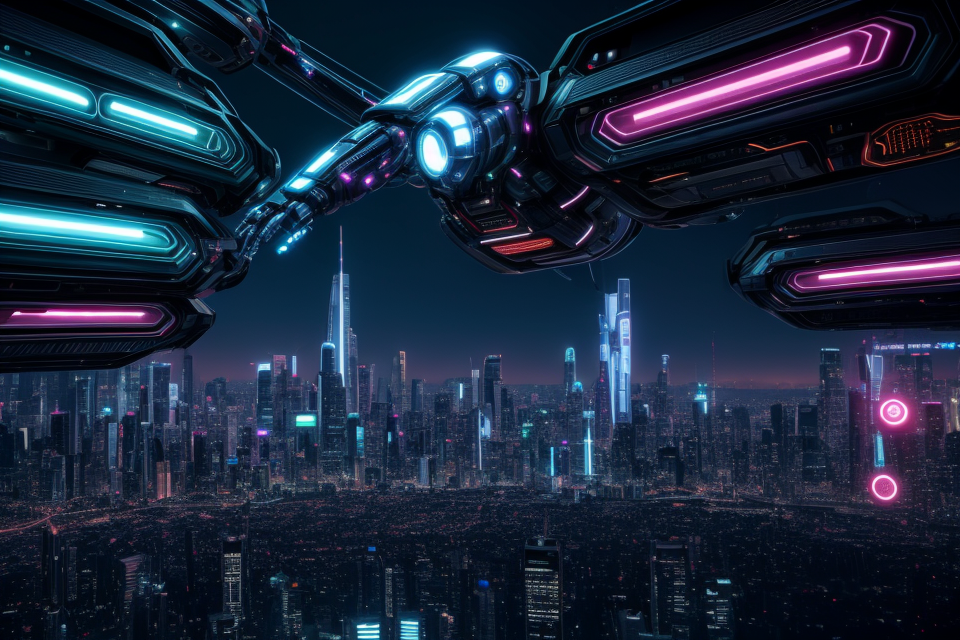Artificial Intelligence (AI) has been a topic of fascination for decades, with advancements in technology leading to its widespread use in various industries. However, there is still much confusion about what constitutes AI. Some may believe that it refers only to humanoid robots, while others may think it includes any machine learning algorithm. In this article, we will delve into the different types of AI and explore what is considered to be AI. We will examine the characteristics that define AI and the factors that distinguish it from other forms of technology. Join us on this comprehensive exploration of AI and discover the truth behind this ever-evolving field.
Definition and Evolution of AI
Historical Overview of Artificial Intelligence
The Birth of AI: Early Theories and Pioneers
Artificial Intelligence (AI) has its roots in ancient myths and legends, where tales of intelligent machines were woven into the fabric of human history. However, it was not until the mid-20th century that the modern concept of AI began to take shape.
In 1956, the term “Artificial Intelligence” was coined by John McCarthy, a computer scientist who envisioned a future where machines could perform tasks that would normally require human intelligence. This vision was shared by other pioneers in the field, such as Marvin Minsky and Norbert Wiener, who made significant contributions to the development of AI.
One of the earliest theories in AI was the symbolic approach, which posited that human thought could be simulated using symbols and rules. This approach was embodied in the Logical Calculus of Ideas, developed by Alan Turing in 1936. Turing’s work laid the foundation for the development of the Turing Test, a measure of a machine’s ability to exhibit intelligent behavior equivalent to, or indistinguishable from, that of a human.
The Driving Forces Behind AI’s Evolution
The evolution of AI has been driven by a combination of technological advancements and practical applications. Key driving forces include:
- The need for automation: As industries expanded and the volume of data increased, the need for automation became more apparent. Machines were developed to perform tasks that were repetitive, dangerous, or too complex for humans to handle.
- Advances in computer hardware: The development of faster and more powerful computers enabled researchers to process larger amounts of data and perform more complex calculations, leading to breakthroughs in AI research.
- Increased interest in cognitive science: The study of the human mind and its cognitive processes fueled research into AI, as scientists sought to understand how humans think and learn, and to replicate these processes in machines.
- The rise of big data: The exponential growth of data in recent years has provided AI researchers with vast amounts of information to analyze and learn from, further accelerating the development of AI.
These driving forces have led to the rapid evolution of AI, from its early symbolic approaches to the development of more advanced techniques such as machine learning, deep learning, and neural networks. As AI continues to evolve, it promises to transform industries and society as a whole, holding the potential to revolutionize the way we live and work.
Modern Approaches to Artificial Intelligence
Deep Learning and Neural Networks
- Introduction to Deep Learning
- Convolutional Neural Networks (CNNs)
- Recurrent Neural Networks (RNNs)
- Long Short-Term Memory (LSTM) networks
- Generative Adversarial Networks (GANs)
- Autoencoders
- Advantages and Applications of Deep Learning
- Limitations and Challenges of Deep Learning
Natural Language Processing
- Overview of Natural Language Processing
- Part-of-Speech Tagging
- Named Entity Recognition
- Sentiment Analysis
- Machine Translation
- Text Classification
- Question Answering Systems
- Challenges in Natural Language Processing
Robotics and Computer Vision
- Introduction to Robotics and Computer Vision
- Robotics Applications
- Computer Vision Techniques
- Object Recognition
- Scene Understanding
- Robot Localization and Mapping
- Applications of Robotics and Computer Vision
- Challenges in Robotics and Computer Vision
Types of Artificial Intelligence
Narrow or Weak AI
Specialized Domains and Applications
Narrow or Weak AI refers to artificial intelligence systems that are designed to perform specific tasks within a limited scope. These systems are typically trained on a specific dataset and are able to perform their task with great accuracy, but they lack the ability to generalize beyond their training data.
Examples of Narrow AI Systems
Examples of narrow AI systems include:
- Siri and Alexa, which are designed to understand and respond to voice commands in a specific domain.
- Self-driving cars, which are trained to recognize and respond to specific road conditions and obstacles.
- Fraud detection systems, which are trained to identify specific patterns of fraudulent behavior within a financial dataset.
- Image recognition systems, which are trained to identify specific objects within an image.
Narrow AI systems are often used in industry and business to automate specific tasks, such as data entry or quality control. They can also be used in scientific research to assist with data analysis and classification. While narrow AI systems are not capable of general intelligence, they can still be very useful and efficient within their specific domain.
General or Strong AI
The Goal of Achieving Human-Like Intelligence
The development of General or Strong AI is focused on creating artificial intelligence systems that can perform a wide range of tasks and have the ability to think and reason like humans. The ultimate goal of this type of AI is to develop machines that can simulate human intelligence, which is known as “Artificial General Intelligence” (AGI). This type of AI aims to create machines that can understand and learn from experience, reason, plan, solve problems, and adapt to new situations in the same way that humans do.
Potential Implications and Limitations
The development of General or Strong AI has the potential to revolutionize many fields, including healthcare, finance, transportation, and manufacturing. It could lead to more efficient and cost-effective solutions to complex problems, improve decision-making processes, and increase productivity. However, there are also significant limitations and challenges associated with this type of AI.
One of the main challenges is the difficulty of creating machines that can truly think and reason like humans. While machines can be programmed to perform specific tasks, they lack the creativity, intuition, and emotional intelligence that humans possess. Additionally, there are concerns about the potential impact of AGI on society, including the potential for job displacement, ethical issues, and the possibility of machines making decisions that have negative consequences for humans.
The Science Behind AI
Machine Learning
Supervised Learning
Supervised learning is a type of machine learning where an algorithm learns from labeled data. The algorithm learns to map input data to output data by modeling the relationship between the input and output data. In supervised learning, the algorithm is given a set of input-output pairs, and it uses these pairs to learn the mapping function.
Supervised learning can be further divided into two categories:
- Classification: The algorithm learns to classify the input data into predefined categories. For example, an image classification algorithm might learn to identify different types of animals in an image based on their features.
- Regression: The algorithm learns to predict a continuous output value based on the input data. For example, a housing price prediction algorithm might learn to predict the price of a house based on its size, location, and other features.
Unsupervised Learning
Unsupervised learning is a type of machine learning where an algorithm learns from unlabeled data. The algorithm learns to identify patterns and relationships in the data without being explicitly told what to look for.
Unsupervised learning can be further divided into two categories:
- Clustering: The algorithm learns to group similar data points together. For example, an image clustering algorithm might learn to group similar images based on their visual features.
- Dimensionality Reduction: The algorithm learns to reduce the number of input features while preserving the most important information. For example, a text dimensionality reduction algorithm might learn to reduce the number of words in a document while preserving its meaning.
Reinforcement Learning
Reinforcement learning is a type of machine learning where an algorithm learns from trial and error. The algorithm learns to take actions in an environment to maximize a reward signal. The algorithm learns by interacting with the environment and receiving feedback in the form of rewards or penalties.
Reinforcement learning can be used for a wide range of applications, such as game playing, robotics, and autonomous driving. The algorithm learns to take actions that maximize the expected reward, given the current state of the environment.
In summary, machine learning is a crucial component of artificial intelligence. It allows algorithms to learn from data and make predictions or decisions based on that data. The three types of machine learning – supervised learning, unsupervised learning, and reinforcement learning – each have their own strengths and weaknesses and are used for different types of problems.
AI Techniques and Methodologies
Deep Learning, Neural Networks, and Natural Language Processing
- Deep learning is a subset of machine learning that uses neural networks to model and solve complex problems.
- Neural networks are inspired by the human brain and consist of interconnected nodes or neurons that process and transmit information.
- Natural language processing (NLP) is a branch of AI that focuses on the interaction between computers and human language.
- NLP techniques include speech recognition, text-to-speech conversion, and sentiment analysis.
Robotics, Computer Vision, and Expert Systems
- Robotics involves the design, construction, and operation of robots that can perform tasks autonomously or semi-autonomously.
- Computer vision is the ability of computers to interpret and understand visual data from the world.
- Expert systems are AI systems that emulate the decision-making ability of a human expert in a specific domain.
- Expert systems use a knowledge base and inference engine to solve problems and make decisions.
- Examples of expert systems include medical diagnosis systems and financial planning tools.
Ethical and Philosophical Implications of AI
AI Bias and Fairness
Algorithmic Bias and its Consequences
The concept of algorithmic bias refers to the phenomenon where algorithms, in their design or application, systematically favor one group over another. This bias can manifest in various ways, such as in the data used to train AI models, the assumptions made by those models, or the decisions taken by systems that use AI.
One notable example of algorithmic bias is the COMPAS (Correctional Offender Management Profiling for Alternative Sanctions) system, which is used by US courts to assess the likelihood of a defendant reoffending. Studies have shown that the system is biased against African-American defendants, leading to a higher rate of false positives for this group compared to white defendants.
Addressing Bias in AI Systems
Addressing bias in AI systems is a complex challenge that requires a multi-faceted approach. One strategy is to improve the diversity of the teams developing AI systems, ensuring that a wide range of perspectives are represented in the design process. Additionally, efforts to collect more diverse data and to validate models for fairness can help to mitigate bias.
Regulatory bodies are also starting to take notice of the issue of algorithmic bias. In 2018, the European Union’s General Data Protection Regulation (GDPR) introduced a “right to an explanation” for citizens, allowing them to request information about how AI systems make decisions that affect them. This transparency can help identify and address bias in AI systems.
In conclusion, addressing bias in AI systems is crucial for ensuring fairness and preventing discrimination. A combination of improved design processes, more diverse data, and increased regulatory oversight will be necessary to mitigate this important ethical challenge.
AI and the Future of Work
Automation and Job Displacement
As artificial intelligence continues to advance, it is inevitable that it will begin to automate certain jobs, potentially leading to job displacement. While some jobs may be completely replaced by AI, others may be transformed, with AI taking over repetitive or dangerous tasks, allowing humans to focus on more creative and strategic work. However, it is important to note that not all jobs can be easily automated, and there will likely be a need for human labor in many industries.
Re-Skilling and Upskilling for the AI Era
As AI begins to take over certain jobs, it is crucial that workers develop new skills to remain competitive in the job market. This means that there will be a growing need for re-skilling and upskilling programs, which will teach workers new skills and prepare them for the jobs of the future. In addition, it is important for educators to begin incorporating AI and automation into their curriculums, so that students are prepared for the changing job market. By investing in re-skilling and upskilling programs, we can ensure that workers are not left behind in the AI era.
Applications and Future Prospects of AI
Industry-Specific AI Applications
Healthcare
Artificial intelligence has revolutionized the healthcare industry by providing advanced diagnostic tools, personalized treatment plans, and improved patient outcomes. AI algorithms can analyze large amounts of medical data, including electronic health records, imaging studies, and genomic sequences, to identify patterns and make predictions. For instance, AI-powered medical imaging tools can detect tumors, abnormalities, and other health issues with greater accuracy and speed than human experts. Furthermore, AI chatbots can assist patients in finding doctors, booking appointments, and answering medical queries, thereby reducing the workload of healthcare professionals.
Finance
AI has significantly impacted the finance industry by automating processes, detecting fraud, and enhancing investment strategies. AI algorithms can analyze financial data to predict market trends, assess credit risk, and optimize investment portfolios. For example, AI-powered fraud detection systems can identify suspicious transactions and flag potential threats, reducing financial losses for banks and other financial institutions. Additionally, AI-driven robo-advisors can provide personalized investment advice based on the user’s risk tolerance, investment goals, and financial situation.
Manufacturing
AI has transformed the manufacturing industry by optimizing production processes, improving product quality, and reducing costs. AI algorithms can analyze production data to identify inefficiencies, predict equipment failures, and recommend preventive maintenance. For instance, AI-powered robots can perform repetitive tasks with high precision and accuracy, reducing the need for human labor. Furthermore, AI-driven supply chain management systems can optimize inventory levels, reduce lead times, and improve delivery reliability.
In conclusion, industry-specific AI applications have transformed various sectors, including healthcare, finance, and manufacturing, by automating processes, enhancing decision-making, and improving efficiency. As AI continues to evolve, it is expected to bring further innovations and opportunities across different industries.
Future of AI and its Impact on Society
The AI Revolution and its Consequences
Artificial intelligence (AI) has the potential to revolutionize society by transforming the way we live, work, and interact with each other. The development of AI has already had a significant impact on various industries, including healthcare, finance, transportation, and manufacturing. As AI continues to advance, it is likely to have an even greater impact on society as a whole.
One of the most significant consequences of the AI revolution is the potential for increased automation. As AI systems become more advanced, they are capable of performing tasks that were previously only possible for humans to perform. This has the potential to significantly change the nature of work, with some jobs becoming obsolete while others are created. The impact of automation on employment and the economy is a topic of ongoing debate and research.
Another consequence of the AI revolution is the potential for increased data privacy and security concerns. As AI systems become more advanced, they are capable of processing and analyzing vast amounts of data. This includes personal data, which raises concerns about privacy and the potential for misuse of this information. Additionally, as AI systems become more autonomous, there is a risk that they could be used for malicious purposes, such as cyber attacks or espionage.
Opportunities and Challenges for the Future
Despite the potential consequences of the AI revolution, there are also many opportunities for the future. AI has the potential to improve healthcare by enabling more accurate diagnoses and personalized treatment plans. It can also be used to improve transportation safety by reducing the risk of accidents and improving traffic flow. In addition, AI can be used to improve energy efficiency and reduce carbon emissions, which is important for addressing climate change.
However, there are also many challenges that must be addressed in order to fully realize the potential of AI. One of the biggest challenges is ensuring that AI systems are developed and deployed in a way that is ethical and beneficial to society as a whole. This includes addressing issues related to bias, transparency, and accountability. Additionally, there is a need for greater investment in education and training to ensure that the workforce is prepared for the changes that AI will bring.
Overall, the future of AI and its impact on society is a complex and multifaceted issue that requires careful consideration and planning. While there are many opportunities for the future, there are also many challenges that must be addressed in order to ensure that AI is developed and deployed in a way that is beneficial to society as a whole.
FAQs
1. What is Artificial Intelligence (AI)?
Artificial Intelligence (AI) refers to the development of computer systems that can perform tasks that typically require human intelligence, such as learning, reasoning, problem-solving, perception, and natural language understanding. AI systems use algorithms, statistical models, and machine learning techniques to process and analyze data, and make decisions or predictions based on that data.
2. What are the different types of AI?
There are several types of AI, including:
* Reactive Machines: These are the most basic type of AI systems, which do not have memory and do not use past experiences to inform their decision-making.
* Limited Memory: These systems use past experiences to inform their decision-making, but only for a limited amount of time.
* Theory of Mind: These systems are capable of understanding and predicting the behavior of other agents, and can adjust their own behavior accordingly.
* Self-Aware: These systems are capable of understanding their own existence and have a sense of self-awareness.
3. What are some examples of AI?
Some examples of AI include:
* Natural Language Processing (NLP): This refers to the ability of machines to understand and generate human language, such as speech recognition and text analysis.
* Computer Vision: This refers to the ability of machines to interpret and understand visual data, such as image and video recognition.
* Machine Learning: This refers to the ability of machines to learn from data and improve their performance over time, without being explicitly programmed.
* Robotics: This refers to the development of machines that can perform tasks autonomously, such as robots that can perform manufacturing tasks or assist with healthcare.
4. How is AI different from human intelligence?
While AI systems can perform tasks that typically require human intelligence, they do not possess the same level of consciousness, emotions, or creativity as humans. AI systems are limited by the data they are trained on and the algorithms they use, and they do not have the ability to reason or make decisions based on moral or ethical principles.
5. What are the potential benefits and risks of AI?
The potential benefits of AI include increased efficiency, improved decision-making, and enhanced creativity. However, there are also risks associated with AI, such as job displacement, bias and discrimination, and the potential for AI systems to be used for malicious purposes. It is important to carefully consider the ethical and societal implications of AI and develop regulations and guidelines to ensure its responsible development and use.



